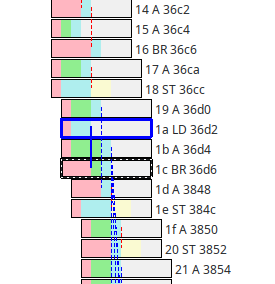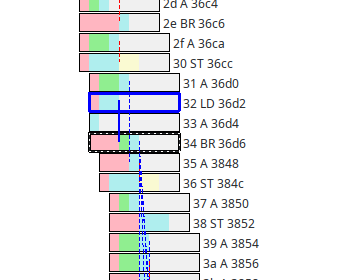VRoom! blog - Experiments in Macro Op Fusion
05 Mar 2023Introduction
Spent some time this week experimenting with macro op fusion. Many of the arguments around the RISCV ISA have been addressed with “you can solve that with macro op fusion” which is the idea that you can take adjacent instructions, next to each other, in an instruction stream and merge them into a single instruction that by itself can’t be expressed directly in the instruction set.
We’ve always planned that VRoom! would support fusion that made sense in the renamer stage (post decode) - today’s work is a trial experiment fusing some common sequences just to get a feel for how hard they are to implement.
Limits
First some limits:
- we’re going to avoid creating new instructions that would require adding more read/write register ports to ALUs
- we’re also going to avoid (this time around) trying to deal with instructions where the second of a pair might fault and not be executed. For example if we fuse ‘lui t0, hi(xx);ld t0, lo(xx)(t0)’ the load might take a page fault and get restarted expecting the side effect of the lui had actually happened - it’s not that this can’t necessarily be done, just that this is hard and we’re performing a simple experiment
Choices
We decided to choose 3 simple instruction pairs, these occur reasonably often in instruction streams and because they involve fused branches and ALU operations they particularly work well with our change a while back to merge our ALU and branch units, the downside is that previously it was possible to build ALUs which shared the adder used by normal addition operations and the magnitude comparator used for branches, now we will need to be able to do both at once.
The first choice is to merge an add immediate, or an add to x0 instruction, and an indirect branch that doesn’t write an output register, this catches a whole bunch of common code that happens at the end of a subroutine:
add sp, sp, 40
ret
li a0, 0
ret
mv a0, s0
ret
The one limitation is that the destination of the add must not be the indirect register used by the jump/ret.
The second and third choices marry a load immediate to a register (add immediate to x0) instruction and a conditional branch comparing that register with another into one instruction
li a0, #5
beq a0, a1, target
li a0, #5
beq a1, a0, target
becomes:
li a0, #5;beq #5, a1, target
li a0, #5;beq a1, #5, target
This mostly means the branch instruction runs one clock earlier, which makes no difference in performance if it is correctly predicted (a predicted branch just checks that it did the right thing and quietly continues on), but reduces mispredicted branch times by effectively 1 clock.
All 3 optimizations free up an ALU slot for another instruction.
Implementation
We perform this optimization in our renamer - remember we have 8 renamers renaming up to 8 decoded instructions from the previous clock. We add logic to each renamer unit to recognize the types of addition operations we want to recognize for the first instruction, and pass that information to the next renamer (the first renamer gets told “no instructions match”).
Each renamer also recognizes the second instruction of the pair and gates that with the match from the previous renamer in the chain. Care is taken to make logic paths that do not go through the full layer of renamers.
If a renamer matches a branch (and a previous add) then it modifies the ‘control’ field (the portion that describes when sort operation is being done, it also tags itself as now creating an output register (and tags the addition’s output register), it also copies the immediate portion of the addition and the source register (in the ret operation case which it fetches as rs2).
If a renamer discovers that it’s feeding an add to a fused pair then it marks itself as not creating an output (doesn’t write a register), this effectively makes it a no-op, the commit stage will mark this instruction as done and it will never be scheduled to an ALU. The renamer logic already contains a layer that packs down decoded instructions, if we used that to remove this instruction it would create circular logic that wouldn’t be synthesisable, If we removed this in the next stage (added a ‘pack’ layer to the logic that feeds the commitQ) it would be very expensive and would break the renaming (which renames to future commitQ locations) - so instead we create a no-op entry (but see below).
The actual implementation in the ALU is pretty simple, we have to allow for a r2+immed addition and for immediates to be fed into the branch comparator.
Further optimization
You likely noticed that we can’t optimize add/branch pairs that cross instruction bundle boundaries (the boundaries in the instruction stream that our 4-8 instruction decoder decodes from). Once we implement a trace cache instruction streams will be presented to the renamer again, each time they are replayed, if such a split instruction pair is presented again here they can be re-optimized.
If we’re running a trace cache we can also purge no-op instructions from the cached instruction stream as it’s filled.
Performance
Here’s a simple example of an add/ret optimization, before the return (in black)

and after:

Notice that the add (at 0x36d4) is nullified, all that green in the instructions around there means that the ALUs are busy so removing one helps. Those blue dotted lines coming down out of the add instruction (dependencies on the new SP) now come out of the branch (return).
So we know it’s working - how much faster is it on our favorite dhrystone benchmark? Like last time it makes no difference at all - at the moment on that benchmark our performance there is completely limited by the issue rate from the instruction fetch/decoders.
We actually don’t expect these optimizations to help dhrystone much anyway as all it’s branches are predicted, and the big advantage of executing branches early is that it speeds up mispredictions. However it will also speed up instruction streams that are ALU bound as it frees up a slot.
Any design is a balance between the decode rate and the rate that the decoded instructions are executed, that balance is going to change with different sets of code. Essentially our current bunch of changes, and last week’s, are building pressure on the execution side of that trade off, we can’t easily speed up the decoder but we will return to our trace cache design which should be able it issue 8 instructions/clock to support that we’ll need more execution capability.
Next time: More misc extensions
